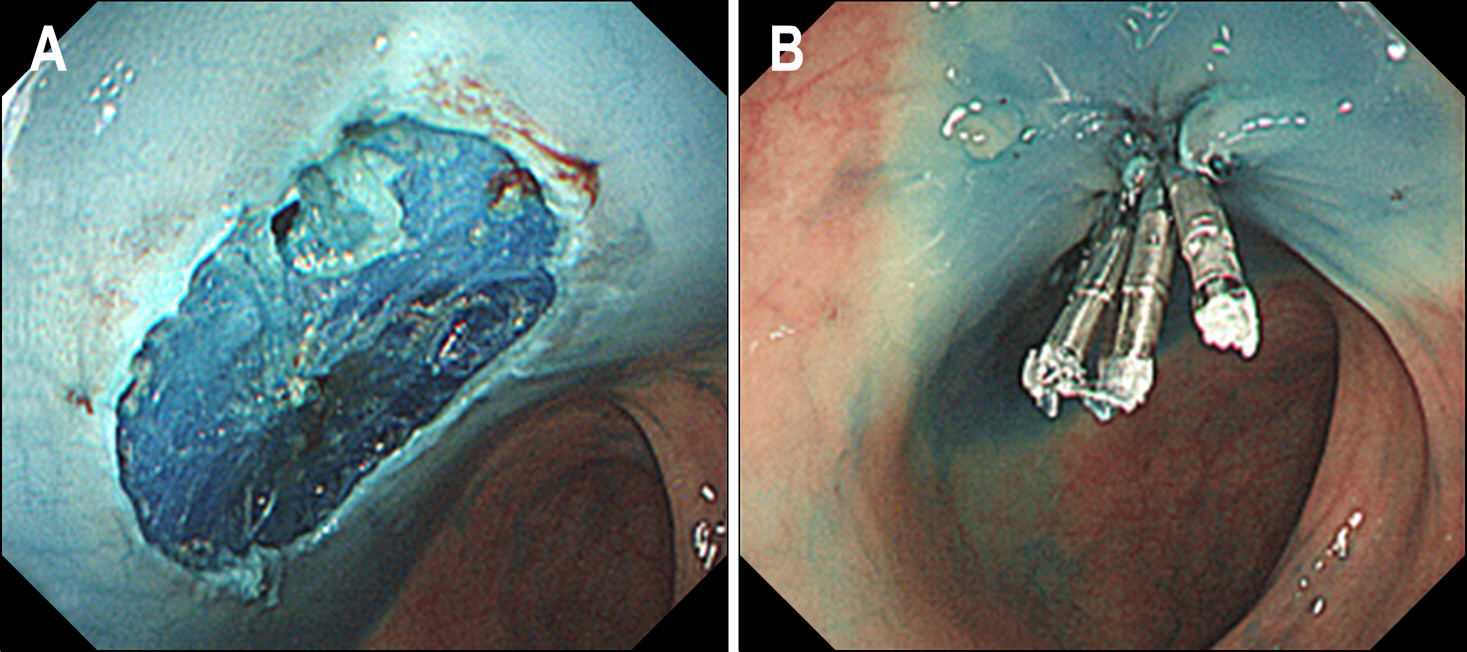Korean J Gastroenterol.
2009 Dec;54(6):371-376. 10.4166/kjg.2009.54.6.371.
Colonoscopic Perforation; A 10-year Experience in Single General Hospital
- Affiliations
-
- 1Department of Gastroenterology, Masan Samsung Hospital, Sungkyunkwan University School of Medicine, Seoul, Korea. jeoh78@yahoo.co.kr
- KMID: 1775936
- DOI: http://doi.org/10.4166/kjg.2009.54.6.371
Abstract
- BACKGROUND/AIMS
Colonoscopy is the principal method for diagnosis, treatment, and follow up of colorectal disease. The study aimed to assess the incidence, clinical features, and management of colonoscopic perforations at a local general hospital. METHODS: A retrospective review of patient record was performed for all patients with iatrogenic colonic perforation after sigmoidoscopy and colonoscopy between 1997 and 2007. RESULTS: In the 10-year period, 16,388 colonoscopic and sigmoidscopic procedure were performed. All 10 cases of procedure related colonic perforation were developed. Perforation occurred in 9 cases during therapeutic procedure; 5 cases due to polypectomy and 4 cases due to endoscopic submucosal dissection. Perforation occurred in one case during diagnostic procedure. CONCLUSIONS: Therapeutic procedure is a clear risk factor of colonic perforation. When colonic perforation occurs, we should be able to make early diagnosis. Early diagnosis can lead to a good treatment and can produce good prognosis with short hospital days.
MeSH Terms
Figure
Cited by 2 articles
-
Mesocolon Laceration Following Colonoscopy
Yong-jun Choi, Jin-Seok Park, Gyung Eun Kim, Jee Young Han, So-Yun Nah, Byoung Wook Bang
Korean J Gastroenterol. 2014;63(5):313-315. doi: 10.4166/kjg.2014.63.5.313.Factors Associated with the Clinical Outcomes of Iatrogenic Colonic Perforation
Hyun Jin Lee, Han Hee Lee, Dae Young Cheung, Jin Il Kim, Soo-Heon Park
Korean J Gastroenterol. 2022;79(5):210-216. doi: 10.4166/kjg.2022.024.
Reference
-
1. Korean Cancer Registry Center, Ministry of Health & Welfare. Annual report of Korean central cancer registry (2002.1-2002.12). Goyang: Korean Central Cancer Registry Center, Ministry of Health& Welfare;2003.2. Nam GH, Cho MK, Lee KH, et al. Management of colonoscopic perforation during colonoscopic procedure. Korean J Gastrointest Endosc. 2005; 30:188–193.3. Wolff WI, Shinya H. Colonofiberscopy. JAMA. 1971; 217:1509–1512.4. Gedebou TM, Wong RA, Rappaport WD, Jaffe P, Kahsai D, Hunter GC. Clinical presentation and management of iatrogenic colon perforations. Am J Surg. 1996; 172:454–457.
Article5. Ghazi A, Grossman M. Complication of colonoscopy and polypectomy. Surg Clin North Am. 1982; 62:889–896.6. Taku K, Sano Y, Fu KL, et al. Iatrogenic perforation associated with therapeutic colonoscopy: A multicenter study in Japan. J Gastroenterol Hepatol. 2007; 22:1409–1414.
Article7. Kim YS, Lee DS, Jung JJ, et al. Complication of colonoscopic polypectomy. Korean J Gastrointest Endosc. 2000; 21:917–923.8. Kavic SM, Basson MD. Complications of endoscopy. Am J Surg. 2001; 181:319–332.
Article9. Damore LJ 2nd, Rantis PC, Vernava AM 3rd, Longo WE. Colonoscopic perforations. Etiology, diagnosis and management. Dis Colon Rectum. 1996; 39:1308–1314.10. Abderson ML, Pasha TM, Leghton JA. Endoscopic perforation of the colon: lesson from a 10-year study. Am J Gastroenterol. 2000; 95:3418–3422.11. George SM Jr, Fabian TC, Voeller GR, Kudsk KA, Mangiante EC, Britt LG. Primary repair of colon wounds. A prospective trial in nonselected patients. Ann Surg. 1989; 209:728–733.12. Lo AY, Beaton HL. Selective management of colonoscopic perforations. J Am Coll Surg. 1994; 179:333–337.13. Orsoni P, Berdah S, Verrier C, et al. Colonic perforation due to colonoscopy: a retrospective study of 48 cases. Endoscopy. 1997; 29:160–164.
Article14. Park HC, Kim DW, Kim SG, Park KJ, Park JG. Surgical management of colonoscopic perforations. J Korean Soc Coloproctol. 2007; 23:287–291.
Article15. Hall C, Dorricott NJ, Donovan IA, Neoptolemos JP. Colon perforation during colonoscopy: surgical versus conservative management. Br J Surg. 1991; 78:542–544.
Article16. Christie JP, Marrazzo J 3rd. “Mini-perforation” of the colon-not all postpolypectomy perforations require laparotomy. Dis Colon Rectum. 1991; 34:132–135.
Article17. Mana F, De Vogelaere K, Urban D. Iatrogenic perforation of the colon during colonoscopy: endoscopic treatment with clips. Gastrointest Endosc. 2001; 54:258–259.18. Lee JG, Cho JW, Kim P, et al. A case of successful endoscopic therapy in iatrogenic perforation of the colon during colonoscopy. Korean J Gastrointest Endosc. 2004; 29:213–216.19. Yoshikane H, Hidano H, Sakakibara A, et al. Endoscopic repair by clipping of iatrogenic colonic perforation. Gastrointest Endosc. 1997; 46:464–466.20. Shin HP, Dong SH, Kim JH, Han YS. A case of iatrogenic rectal perforation repaired by endoscopic clipping. Korean J Gastrointest Endosc. 2003; 26:232–235.21. Miyahara M, Kitano S, Shimoda K, et al. Laparoscopic repair of a colonic perforation sustained during colonoscopy. Surg Endosc. 1996; 10:352–353.
Article22. Choi KH, Hong YS, Suh SO, Moon HY. Colon perforation. J Korean Soc Coloproctol. 1999; 15:307–314.
- Full Text Links
- Actions
-
Cited
- CITED
-
- Close
- Share
- Similar articles
-
- Recurrent Colonic Perforation after Successful Conservative Treatment of Colonoscopic Perforation
- Pneumothorax, Pneumomediastinum, Subcutaneous Emphysema, Pneumoretroperitoneum Secondary to Colonoscopic Perforation
- Single port laparoscopic repair of sigmoid colon perforation during colonoscopy
- Colonoscopic Perforations: 4 Years' Experience
- Safety of Conservative Treatment of Colonoscopic Perforation



